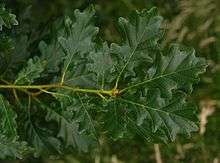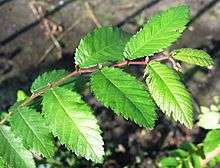Rose Motif

The Rose Motif is a collection of plant characteristics utilized for diagnosing plant families in Dr. J. Richard Abbott's field botany course at Murray State University's Hancock Biological Station. These characteristics primarily identify the Rosaceae family and then with the addition of other characteristics can be used to identify Betulaceae, Cannabaceae, Fagaceae, and Ulmaceae.[1] This approach is not meant to be comprehensive nor exhaustive, but is focused on vegetative features, especially for common plants in eastern North America. Rosaceae mostly have relatively showy, perfect flowers with a hypanthium and are often herbaceous, whereas the other families have relatively inconspicuous, unisexual flowers without an obvious hypanthium and are all woody (except for Cannabis & Humulus in the Cannabaceae).
Characteristics
The Rose Motif is recognized by Herbaceous or Woody, simple or sometimes compound leaves, alternate leaf phyllotaxy, toothed leaves, with stipules. These character by themselves represent the Rosaceae family and with the addition of other characters the separation of the other related plant families can be obtained[1] with the understanding that there are exceptions to most of these norms.
Rosaceae
Roses, cherries, plums, and apples trees are part of this family. Usually in the eastern US, when the rose motif is present with compound leaves and no representatives characteristics of the other families in this group, it is probably a member of Rosaceae. The members of the genus Prunus (wild black cherry, American plum) have simple leaves and petiole glands.

Betulaceae
Members of this family include the birch and alder trees. These trees exhibit the rose motif as well as having doubly serrate leaves with veins that are fairly straight, even, and parallel, and/or peeling bark and horizontal lenticels.[2][3]
Cannabaceae
The sugarberry and hackberry family. These trees demonstrate the rose motif and chambered pith, 2-ranked leaves, and their leaves are plinerved.
Fagaceae

The oak family. These rose motif trees, primarily the genus Quercus, stand out by having heavily lobed leaves that are clustered around the tip of the branch. Other genera are unlobed, not always clustered, and are not readily distinct from Rosaceae vegetatively without imprinting the genera.[3]

Ulmaceae
The elm tree family. To tell these trees apart from other rose motif trees, look for their alternate 2-ranked, often scabrous leaves. The Ulmus genus are strongly toothed and have asymmetrical leaf bases with secondary veins scalariform and usually ending in teeth. The Ulmus also have samara.[3][4]
References
- 1 2 Dr. J. Richard Abbott. 2016. Plant family short descriptions. Unpublished.
- ↑ Struwe, Lena (2009). "Field identification of the 50 most common plant families in temperate regions" (PDF). Rutgers University. Retrieved 2016-06-26.
- 1 2 3 Castner1 and Abbott2, James1 and Richard2 (2004). Photographic atlas of botany and guide to plant identification. Gainsville, FL, USA: Feline Press. pp. 162–176. ISBN 978-0-9625150-0-2.
- ↑ "Hardwood Anatomy | The Wood Database". www.wood-database.com. Retrieved 2016-06-26.